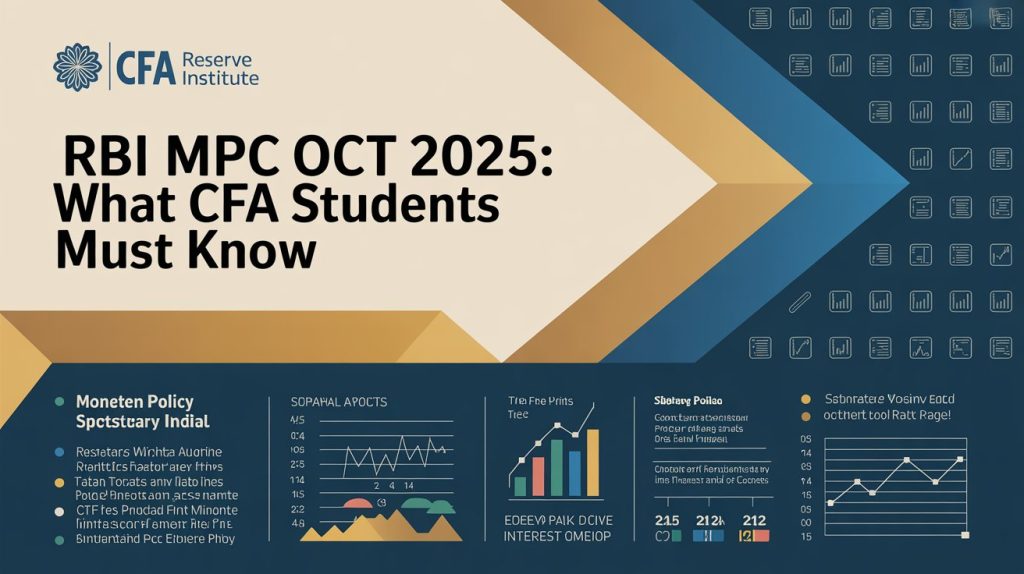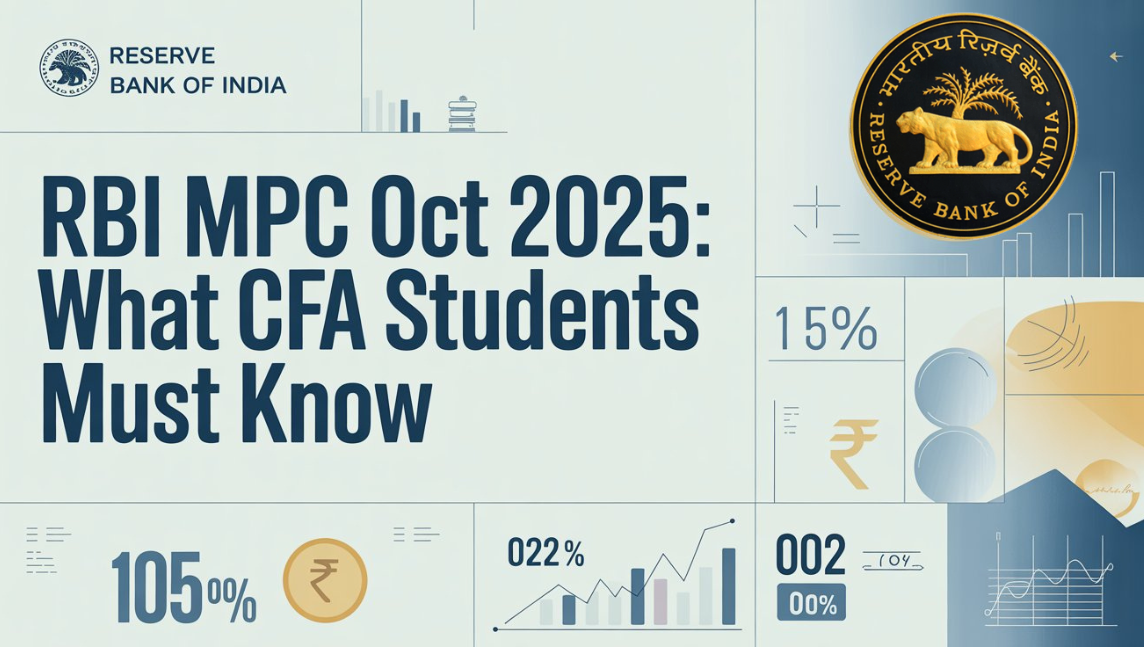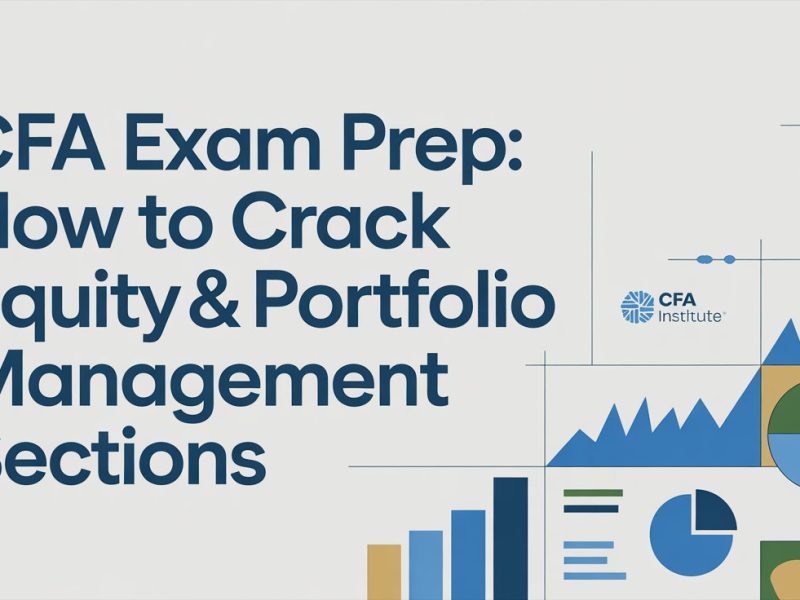It’s that moment when financial news flashes, and a tiny panic sets in, “What does this RBI MPC 2025 decision mean for me, my exams, or the markets?” At first, the numbers and terms can feel like a confusing maze. However, once you break them down and see how they connect to real-world outcomes, everything falls into place.
This article is your shortcut: a clear, practical guide to the RBI MPC October 2025 meeting, showing exactly what CFA students need to know. By the end, you’ll not only understand the numbers and their impact but also be ready to apply them in exams, case studies, and investment decisions.
Overview of RBI MPC 2025 and Its Decisions
The Reserve Bank of India’s Monetary Policy Committee (MPC) met in October 2025 to decide the direction of India’s economy, and the outcome was balanced, not dramatic. The RBI decided to keep the repo rate steady at 5.50%, the same as after the June 2025 cut. In easy words, this means the RBI wants to support growth but without letting inflation get out of hand.
India’s GDP growth forecast got a small boost to 6.8% for FY 2025–26, driven by strong local demand, steady investments, and continued government spending. Inflation, on the other hand, is expected to stay around 2.6%, comfortably within the target range of 2–6%. The Cash Reserve Ratio (CRR) remains at 3%, helping banks keep enough liquidity to lend smoothly. (RBI’s press release page)
For CFA students, these figures are more than just numbers; they’re real-world lessons. Understanding how repo rates, inflation, and GDP connect can help you see how the economy breathes and moves. The RBI MPC 2025 meeting isn’t just a report to memorize; it’s a story about how India balances growth and stability.
Monetary Policy Transmission: How RBI MPC 2025 Impacts the Economy
At first, monetary policy transmission might sound like one of those complex finance terms, but it’s really simple. It just means how the RBI’s decisions flow through the system and impact things like loans, investments, and overall economic activity.
Since the repo rate stayed steady at 5.50%, banks aren’t expected to change their lending rates much. In everyday terms, that means your EMIs, corporate loans, and even bond returns are likely to stay stable, a bit of calm in an otherwise unpredictable economy.
Think of it this way: when borrowing costs don’t suddenly jump, real estate projects can move forward smoothly, and investors in fixed-income assets can breathe easy knowing their returns won’t swing too wildly.
For CFA students, this is a great example of how policy connects to real-world markets. Understanding this link between RBI MPC 2025, lending rates, and sector performance helps make those tricky exam case studies much easier to decode. Once you see how these pieces fit together, the whole concept starts to feel less like theory and more like watching the economy in action.
Sectoral Impact Analysis: Who Wins and Who Loses
Not every sector feels the impact of the RBI’s decisions in the same way. Some benefit right away, while others need to tread carefully. Let’s look at it simply:
- Banking: This sector gets a boost from steady liquidity and stable interest rates. Banks can lend more easily and plan ahead without sudden changes.
- Real Estate: Things look cautiously positive here. Home loans stay affordable, which keeps buyers interested, though big investments still move at a careful pace.
- Manufacturing: This one has a tougher road. Rising global raw material costs and supply chain hurdles continue to slow down growth.
- FMCG & IT: These sectors stay mostly steady. They don’t get affected much by rate changes and keep performing consistently.
For CFA students, this is where it all starts to connect. Imagine a case study asking where you’d invest after the RBI MPC 2025 meeting. Banking and real estate might seem more promising, while manufacturing calls for caution. Understanding these patterns helps you think like an analyst, not just a student. It’s about seeing how one policy move can ripple through different parts of the economy.
Global Economic Interactions and RBI MPC 2025
The RBI doesn’t make its decisions in isolation; it’s always watching what’s happening around the world. Global trends from US interest rate moves to oil price changes and trade tensions all play a big role in shaping India’s monetary policy.
Take the US Federal Reserve, for example. If it raises interest rates, foreign investors often pull money out of emerging markets like India and move it to the US for better returns. That can make the rupee weaker and push up import costs. Add higher oil prices or trade restrictions to the mix, and inflation starts to climb.
So when the RBI chose to maintain a neutral stance in October 2025, it wasn’t just looking at domestic numbers. It was balancing global risks with India’s growth needs, a delicate act of keeping inflation steady while encouraging investment. (RBI Monetary Policy Report – October 2025)
For CFA students, this is where global awareness becomes a real advantage. In the exam, you might see a question linking India’s monetary policy to global rate hikes or currency movements. If you understand how RBI MPC 2025 fits into the bigger global picture, you’ll be able to connect the dots easily and that’s what separates a memorized answer from a thoughtful one.
Forward Guidance and Market Expectations
When the RBI talks about forward guidance, it’s basically giving the markets a hint, a gentle nudge about where things might be headed next. It’s not a direct action, like changing the repo rate, but more like saying, “Here’s how we’re thinking right now.”
In the October 2025 meeting, the RBI chose to keep the repo rate unchanged at 5.50% and maintained a neutral stance. That was its way of signaling calm confidence inflation is under control, growth is steady, and the central bank is ready to adapt if global conditions shift.
For investors, that’s comforting news. Stable policies mean predictable borrowing costs, which keep stock markets less jittery and help businesses plan long-term. It’s like knowing the weather forecast before heading out, even if it’s cloudy, at least you know what to expect.
For CFA students, understanding forward guidance is a secret weapon. It helps you read between the lines of policy announcements and anticipate what might come next. When you can interpret these signals, portfolio strategy questions and market behavior scenarios start making much more sense because you’re not just reading the news, you’re decoding it.

How CFA Students Can Use RBI MPC 2025 Insights
- Key numbers matter: Repo 5.50%, GDP 6.8%, inflation 2.6%. Know them. They often show up in exams.
- See the links: Stable rates → predictable loans, steady investments, smoother markets.
- Sector check: Banking & real estate gain; manufacturing may struggle.
- Think like a pro: Use RBI updates to practice exam case studies and investment strategies.
- Revision hack: Following MPC moves helps connect theory with real-world markets.
Think of it as turning RBI policy updates into a personal cheat sheet. Every number and decision has a story, and understanding that story helps CFA students not only in exams but also in real-world financial decision-making.
Key Takeaways
- Repo rate: Unchanged at 5.50%
- CRR: Steady at 3%
- Inflation forecast: 2.6%, within RBI’s 2–6% target
- GDP growth forecast: 6.8% for FY 2025-26
- Policy stance: Neutral, balancing growth with price stability
- Sectoral winners: Banking, Real Estate
- Sectors under pressure: Manufacturing
- Global factors: US Fed policy, oil prices, trade tensions considered
- Forward guidance: Signals stability and cautious optimism
This cheat sheet ensures quick revision and helps CFA aspirants connect RBI MPC 2025 numbers to exam questions and real-market analysis.
Conclusion
Understanding the RBI MPC 2025 isn’t just about clearing the CFA exam; it’s about thinking like a finance professional. These policy decisions affect investments, sectors, and the overall economy. Following them helps you sharpen analytical skills, make smarter decisions, and see how India’s financial landscape really works.
Keeping up with RBI updates turns into a habit of spotting market trends, decoding sector impacts, and connecting macroeconomic dots. In short, the RBI MPC 2025 isn’t just a report; it’s a roadmap for understanding finance, exams, and real-world markets.
To put this knowledge into practice and master CFA concepts, explore the CFA Coaching Classes by The WallStreet School.
People also ask:-
1. Will RBI cut repo rate in 2025?
Ans. As of the October 2025 MPC meeting, the RBI has kept the repo rate steady at 5.50%. Any future cuts will depend on inflation trends and economic growth.
2. What is the result of RBI MPC meeting 2025?
Ans. The October 2025 MPC meeting kept the repo rate at 5.50%, maintained the CRR at 3%, projected GDP growth at 6.8%, and inflation at 2.6%, signaling a neutral policy stance.
3. Who are the members of RBI Monetary Policy Committee 2025?
Ans. The RBI MPC 2025 consists of six members: three RBI officials, including the Governor, and three external experts appointed by the government.
4. Can MPC members be reappointed?
Ans. Yes, MPC members can be reappointed after their term ends, based on government and RBI approval.



